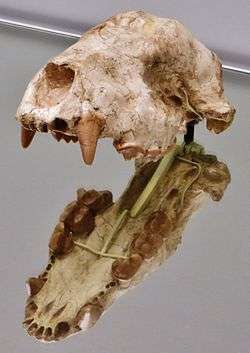Indarctos
| Indarctos | |
|---|---|
 | |
| I. atticus skull | |
| Scientific classification | |
| Kingdom: | Animalia |
| Phylum: | Chordata |
| Class: | Mammalia |
| Order: | Carnivora |
| Suborder: | Caniformia |
| Superfamily: | Arctoidea |
| Family: | Ursidae |
| Subfamily: | Ailuropodinae |
| Tribe: | †Indarctini Abella et al., 2012 |
| Genus: | †Indarctos Pilgrim, 1913 |
| Type species | |
| †Indarctos salmontanus Pilgrim, 1913 | |
| Species | |
|
†I. punjabensis (Lydekker, 1884) | |
Indarctos is a genus of mammals of the bear family, Ursidae, endemic to North America, Europe and Asia during the Miocene. It was present from ~11.1 to 5.3 Ma, existing for approximately 6.2 million years.
The oldest member is from Arizona (~11.1—7.7 Ma) and youngest is (~9.0—5.3 Ma) from Kazakhstan. In North America this animal was contemporary with Plionarctos (~10.3—3.3 Ma).
Taxonomy
Indarctos was named by Pilgrim (1913) Its type is Indarctos salmontanus. It was assigned to Agriotheriini by Chorn and Hoffman (1978); to Ursavini by Hunt (1998); and to Ursidae by Pilgrim (1913), Carroll (1988) and Salesa et al. (2006).[3][4][5] Abell et al. (2012) designated the genus in a new tribe Indarctini and assigned it to Ailuropodinae.[6]
Morphology
Body mass
Two specimens were examined by Legendre and Roth for body mass.[7]
- Specimen 1 estimated to weigh: 244.4 kg
Fossil distribution
Sites and specimen ages:
- Box T Site, Lipscomb County, Texas ~9.3—9.2 Ma.
- Rattlesnake site, Grant County, Oregon ~10.3—4.9 Ma.
- Withlacoochee River Site 4A, Marion County, Florida paleontological sites (Indarctos sp.) ~10.3—4.9 Ma.
- Lufeng, Yunnan, China (I. atticus) ~9—5.3 Ma.
- Yulafli (CY), Thrace, Turkey (I. arctoides) ~9.7—8.7 Ma.
- Batallones-3, Madrid Basin, Spain (I. arctoides) ~11.6—5.3 Ma.[8][9]
References
- ↑ Qiu, Zhan-Xiang; Tedford, R. H. (2003). "Shānxī bǎo dé yìndù xióngyīxīn zhǒng" 山西保德印度熊一新种 [A New Species of *Indarctos* from Baode, China] (PDF). Vertebrata PalAsiatica. 41 (4): 278–288.
- ↑ MacDonald, J. R. (1959). "The Middle Pliocene Mammalian Fauna from Smiths Valley, Nevada". Journal of Paleontology. 33 (5): 872–887. JSTOR 1300922.
- ↑ Chorn, John; Hoffmann, Robert S. (1978). "Ailuropoda melanoleuca". Mammalian Species (110): 1–6. doi:10.2307/3503982. JSTOR 3503982.
- ↑ Hunt, R. M. (1998). "Ursidae". In Jacobs, Louis; Janis, Christine M.; Scott, Kathleen L. Evolution of Tertiary Mammals of North America: Volume 1, Terrestrial Carnivores, Ungulates, and Ungulate like Mammals. Cambridge, UK: Cambridge University Press. pp. 174–195. ISBN 0-521-35519-2.
- ↑ Salesa, M. J.; Anton, M.; Peigne, S.; Morales, J. (2005). "Evidence of a false thumb in a fossil carnivore clarifies the evolution of pandas". Proceedings of the National Academy of Sciences. 103 (2): 379–382. doi:10.1073/pnas.0504899102. PMC 1326154.
- ↑ Abella, Juan; Alba, David M.; Robles, Josep M.; Valenciano, Alberto; Rotgers, Cheyenn; Carmona, Raül; Montoya, Plinio; Morales, Jorge; O’Grady, Patrick (2012). "Kretzoiarctos gen. nov., the Oldest Member of the Giant Panda Clade". PLoS ONE. 7 (11): e48985. doi:10.1371/journal.pone.0048985.
- ↑ S. Legendre and C. Roth. 1988. Correlation of carnassial tooth size and body weight in recent carnivores (Mammalia). Historical Biology 1(1):85-98
- ↑ Batallones-3 site
- ↑ Abella J, Valenciano A, Pérez-Ramos A, Montoya P, Morales J (2013) On the Socio-Sexual Behaviour of the Extinct Ursid Indarctos arctoides: An Approach Based on Its Baculum Size and Morphology. PLoS ONE 8(9): e73711. doi:10.1371/journal.pone.0073711